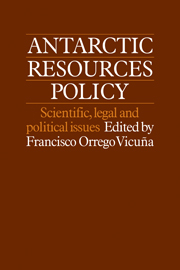Book contents
- Frontmatter
- Contents
- List of contributors
- 1 Antarctic resources policy: an introduction
- Part one The state of Antarctic knowledge and experience
- 2 Antarctica: its history and development
- 3 The living resources of the Southern Ocean: a scientific overview
- 4 The mineral resources of Antarctica: progress in their identification
- 5 Environmental factors in the development of Antarctica
- 6 Cooperation in the Antarctic: a quarter of a century's experience
- Part two The policy for the conservation of the living resources of Antarctica
- Part three The policy for the exploration and exploitation of the mineral resources of Antarctica
- Part four Issues on Antarctica and the law of the sea
- Part five The policy for Antarctic cooperation
2 - Antarctica: its history and development
Published online by Cambridge University Press: 06 July 2010
- Frontmatter
- Contents
- List of contributors
- 1 Antarctic resources policy: an introduction
- Part one The state of Antarctic knowledge and experience
- 2 Antarctica: its history and development
- 3 The living resources of the Southern Ocean: a scientific overview
- 4 The mineral resources of Antarctica: progress in their identification
- 5 Environmental factors in the development of Antarctica
- 6 Cooperation in the Antarctic: a quarter of a century's experience
- Part two The policy for the conservation of the living resources of Antarctica
- Part three The policy for the exploration and exploitation of the mineral resources of Antarctica
- Part four Issues on Antarctica and the law of the sea
- Part five The policy for Antarctic cooperation
Summary
Discovery and exploration
It was the Ancient Greeks who first conceived the idea of a frigid ‘South Land’ to ‘balance’ the cold Arctic regions in the north – hence the name ‘Antarctic’ for the sixth continent. It was not until the fifteenth century that ships were being built large enough to permit long ocean voyages, and this led to the famous journeys of Diaz, Drake, Magellan, Tasman and others, all of which reduced the possible size of the South Land. Between 1772 and 1775 Captain Cook circumnavigated the world further south than anyone before him, twice crossing the Antarctic Circle. Everywhere he found his way barred by impenetrable ice fields, and he came to believe that ‘they extended quite to the Pole’.
Cook's reports of fur seal colonies created great commercial interest, and in 1778 British sealers began work at South Georgia. By 1791 there were at least 102 ships engaged in taking fur seal pelts and elephant seal oil in the Southern Ocean – all of them either American or British vessels.
It was between 1791 and 1794 that the United States sent south the first combined whaling and sealing expedition comprising three ships, and they became the first Americans to visit the Isles de Kerguelen. By 1813 the Australians were sealing at Macquarie Island, the Argentines at the South Shetlands in 1819, and the French at Kerguelen in 1825.
- Type
- Chapter
- Information
- Antarctic Resources PolicyScientific, Legal and Political Issues, pp. 13 - 20Publisher: Cambridge University PressPrint publication year: 1983
- 1
- Cited by



